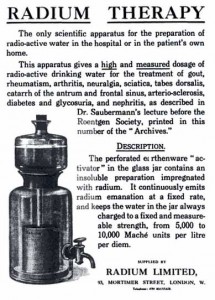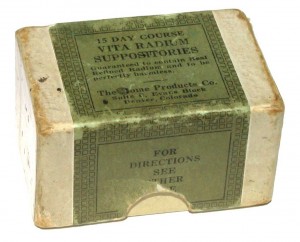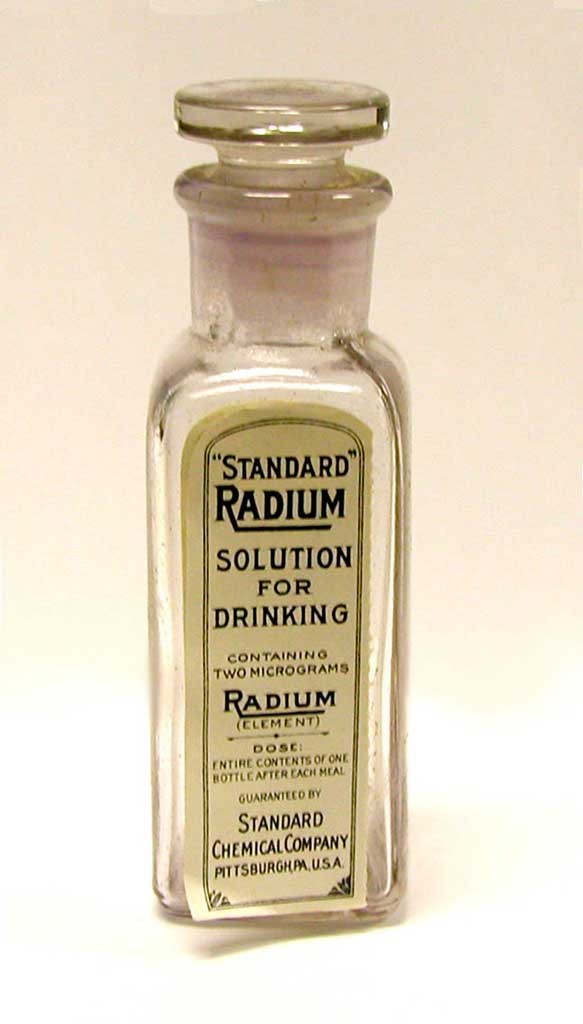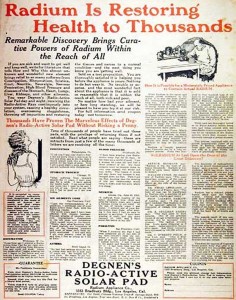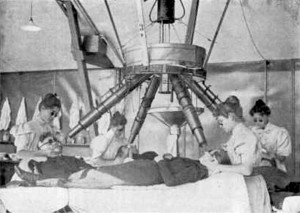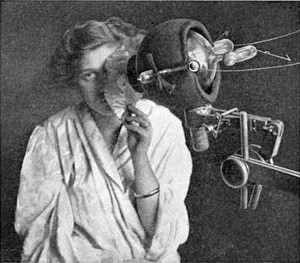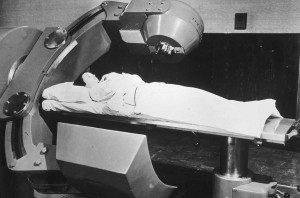Forskning
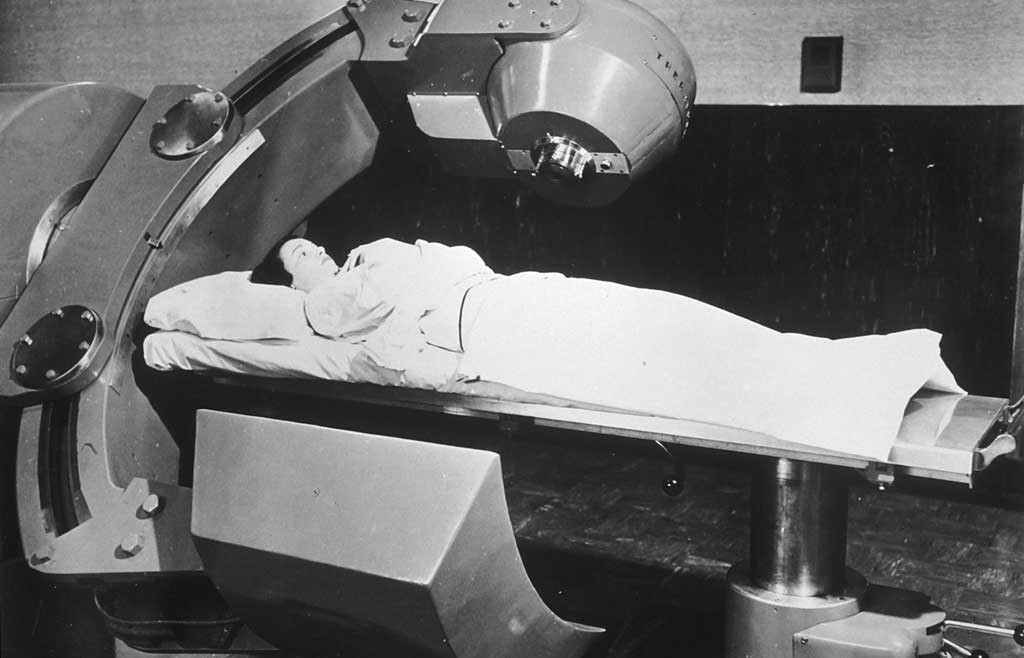
The end of Radiotherapy
M. van Vulpen M.D. PhD, Inaugurational speech M. van Vulpen M.D. PhD, 19th June 2012, Imaging division, University Medical Center Utrecht
To the esteemed Rector Magnificus,
my dear colleagues,
dear colleagues from Europe, the United States and Canada,
dear patients and patient-group advocates,
my dear family and friends,
dear audience,
Inroduction
The end of Radiotherapy. Even the Mayas predicted this for 2012. Nevertheless, my speech does not really concern radiotherapy. It pertains to how the healthcare system is organised and how that affects the patient. Practically speaking, our healthcare system is divided into various specialties such as radiotherapy, surgery and many others. One could compare the organisation of these specialties with ‘columns’; like upright rectangular blocks, if you will. Most specialist healthcare is organised within such a column, each representing the relevant area of expertise. Contact between specialists, between the columns, appears to be less relevant. The word ‘column’, therefore, can be interpreted as a type of barrier; one area of expertise ends where the other begins. Unfortunately, this leads to the under-utilisation of useful expertise as well as to overabundant patient treatment. In addition, it seems that the patient must exert a fair amount of effort to be able to follow such an inter-columnar course of treatment, which can justifiably lead to much frustration and not only for the patient! Radiotherapy is one such established column; this specialty has undergone major changes over the past 10 years and developments continue to the present day. In light of the trend toward a decline in the number of surgeries being performed, radiotherapeutic solutions have evolved the most and have been the most successful. If progression is to continue, radiotherapeutic expertise must not remain restricted to radiotherapy alone. In fact, this appears to be such a major development in that it no longer fits into the boundaries of our radiotherapy-specialty column. There have been worldwide efforts to redefine the radiotherapeutic barriers and radiological expertise; however, this is not what the patients or the healthcare systems really want. THIS, therefore, is the perfect time to rotate the healthcaresystem columnar structures with a one-quarter turn and to come up with a structure in which the patient assumes the central role. Changing how specialist care is managed, more specifically to a type of structure in which the patient assumes the central role, must be undertaken intelligently: SMART. Such a change would otherwise not be successful. During my speech, I intend to present a solution to the issue of changing the structural organisation into integrated care pathways from which all may benefit: the patient, the physician, and the rest of the healthcare chain. This is the only way a one-quarter turn could be practically feasible. Let us start at the beginning: with the patient.
The patient AND the healthcare system
I’d like to tell you a true story. Nothing unusual; just an ordinary story. Introducing: Mrs B; I’ll subsequently call her Anne. She’s 52 years old, married, and has 3 children. She and her family live here in Utrecht. A short time ago, Anne visited a breast-cancer screening bus, where an abnormality was detected in her left breast. It turned out to be breast cancer. The ground fell out from beneath her feet. There was hardly even time to let everything sink in, even though the doctors told her it was a small abnormality that would be easy to treat. She recently had surgery for it. Because the abnormality was so small, the surgeon couldn’t feel it very well. Someone from a different department (radiology), therefore, first inserted a wire with a hook on it into the tumour so that the surgeon would know where the tumour was located during the operation. The operation was subsequently performed under general anaesthesia. Her husband and children waited in the corridor. Fortunately, the surgeon had said, the operation went well; however, the breast didn’t look too good over the course of the following days. Anne has an appointment at the surgeon’s today. An important appoint, because the tissue that had been removed from the breast had been examined at the pathology department and this outcome would determine which other treatments she would have to undergo. A tense situation. She and her husband hadn’t slept very well. Let us now shadow Anne while she visits the outpatient clinic at our hospital. This is easier said than done. First of all, the parking garage was full; she had to wait until she and her husband could park their car. Once inside the hospital, Anne had to seek out the correct route; after all, she hadn’t been to the outpatient clinic very often. She was advised by a friendly employee to follow the purple dotted line and did manage finally to arrive on time. Fortunately, she and her husband were not too late, even though there had been a lot of stress. She and her husband then waited 25 minutes for the doctor to see them. During their wait, the medical assistants closed the patient window’s rolling shutters because it was 4 p.m. and they were done for the day. Anne suddenly doubted whether she had been sitting in the correct waiting room. When they were finally seated in front of the doctor, he did not excuse himself for the delay. It is normal that patients wait. All consultations run over. During the 6 minutes that she and her husband were there, they heard that this doctor’s contribution to her treatment had been successful; hooray. The tumour had been completely removed and hadn’t appeared very aggressive, whatever that meant. A letter had been sent to the radiotherapy department which would conduct the subsequent treatments; 35 radiotherapy sessions it was to be. No, the doctor didn’t know when the next appointment would be; that was a different department. If they hadn’t heard anything, however, they could always call him again. He would then follow up on it. It wasn’t until two weeks later that she was seen by the doctor at the other department: radiotherapy. This doctor told her that she only needed 16 treatments. 16? Not 35? No, they also hadn’t heard that she’d had difficulty raising her arm since the operation. It appeared that this first needed to be resolved before radiation treatments could take place. The radiotherapy sessions were eventually suspended for 4 weeks. For the same reason, physiotherapy had been requested only when she had visited the other department and not sooner. A scan had to be taken for the radiation beams to hit the precise target. These preparations, including computer scheduling, took another 2 weeks. Anne and her husband complained in the car. What kind of conveyor belt are we on? Couldn’t they have made these preparations sooner? Do those doctors and department employees even talk to each other? Why doesn’t that doctor know how many radiation treatments are to be given? Won’t the chance for a cure be hampered by all this waiting? Why, actually, do all the consultations run over? Why can’t all these appointments take place consecutively on one day, if that’s possible? And that was just the beginning. Anne and her husband decided to follow the diplomatic course. It was better to complete the therapy than to have an angry doctor on your hands because you chose to express your doubts and worries. Wouldn’t that just be rocking the boat?
If one looks at the situation from a distance, one can see that there is a ravine between Anne, the patient whom this all concerns, and the hospital. The structural organisation of the hospital appears to focus on the hospital itself and less so on the patient. One can also see that doctors from one area of expertise really don’t know what exactly is going on in the other area of expertise, the other column. This is apparently considered to be less important than work performed within one’s own specialty. It also appears that simple information which could be beneficial to the treatment is not being exchanged, and that Anne’s appointments are actually not being arranged in a coordinated fashion.
Unfortunately, I’m not telling you anything new.
The physician IN the healthcare system
Doctors experience quite a bit of pressure. There are many negative statements related to doctors’ functioning flying about. They suffer from this. As an individual, one perceives that there are many bad doctors; for example, that their expertise and willingness to operate outside of their own specialty appears to stop there. I personally believe that all physicians really do attempt to do their best for the patient and organisation. I suspect that the structural organisation of healthcare is what impedes their optimal functioning. Even worse: I will show you how the ability to practise according to the Hippocratic Oath, which all doctors have sworn to, is coming under pressure by the current organisation of healthcare. A random example from the literature: our colleague Tombal from Brussels held a survey amongst physicians in Europe; he asked urologists and radiotherapists which treatment they believed was better for patients with prostate cancer: surgery or radiotherapy. I suspect you know the answer before even having read the survey responses and you are correct: 92% of the urologists believed that surgery would be better in terms of healing, adverse effects, and quality of life; of the radiotherapists, 85% believed that radio-therapy would result in the same! Hardly any physicians seriously believed that a treatment performed outside their column would be a better alternative than one from their own column. That can no longer be considered coincidental. By the same token, these same doctors believed it unethical to conduct
research into which treatment, operating or radiation, actually would be the best. Unethical? Why would comparing different treatment options be unethical? It appears inconceivable when observed from a distance; there exists both a preference for one’s own type of therapy and the impossibility of research into the best treatment. One would think that a doctor who desires what’s best for the patient would look over the walls of his own column when advising on the best treatment, just as he swore to do when taking the Hippocratic Oath. I will make the patient’s interests my top priority and will respect his opinion. I will not harm the patient. I will listen to him and advise him well. I recognise my own limitations. This is currently not always the case. A physician does not seem to be able to advise his patient independently, never mind being able to independently make decisions for him! To me, this is a major red flag.
I could give you some more examples, although I will not. I’d rather show you the signals that indicate that the physicians themselves are possibly unhappy with the current system. An American study has revealed that 50% of more than 4000 medical students are showing signs of burnout; suicidal ideation occurs in 10%. In the Netherlands, Prins and others have also demonstrated this in more than 2000 students. Signs of burnout are seen in 21% here. Even if the 21% were to be an overestimation, burnout in the general population occurs in less than 10%. In addition, the Dutch study demonstrates an obvious relationship between burnout and suboptimal patient care. Initiatives such as ‘Compassion for Care’ explain the high burnout rate: doctors cannot effectively incorporate the ‘compassion’ that they feel for their patients into daily practise. In other words, all physicians want to do their best for each patient, however; they realise that the current organisational structure is a hindrance to optimal patient care. Such a realisation is not apparent when one is busy performing his or her daily activities; small frustrations are more readily perceived. The realisation hits home only when one takes a step back and evaluates; something physicians don’t have time for. How, then, did this manner of structurally organising come to be? Who invented it? To answer this, I’d like to take you back into the History of Medicine.
The history of medicine
The practise of medicine is as old as mankind itself. Much has been achieved, and we can be proud of our current state of knowledge. After the Middle Ages, organised and professional medicine arose along with the establishment of the first universities back in the 12th century. For the first academic physicians, pondering was their primary task. The actual work was done by barber/surgeons. There were no different specialties; the various columns did not exist back then. The barber/surgeons pulled the occasional tooth, cared for wounds and fractures, and performed bloodletting. Due to the great technical developments of that time, it became necessary to divide the occupation of barber/surgeon up into several different areas of special expertise. That was a good idea, of course, because one single doctor could no longer keep up with all the complicated technical advances. In my opinion, it was not a conscious decision to differentiate the areas of expertise in the way that these are separated today. I believe that this spontaneously came to be as a result of new developments. For this reason, the divisions are not entirely logical. There was no master plan. If you look at the various subspecialties, you can clearly see what I mean. Specialties are in fact subdivided into e.g. illnesses, or organs, or processes, or roles within the healthcare system. For example, we have gene technologists, pulmonologists, immunologists, general practitioners, and even, radiotherapists. If one views these differentiated areas of expertise as being upright rectangular blocks/columns, representing our current healthcare system’s organisational structure, it is plain for all to see that conjoining the various subspecialties would be difficult. They don’t fit together. And, something that doesn’t fit together could never be a solid foundation for optimal patient care.
Even the organisational structuring within the various specialty areas themselves has not developed in line with optimal care for the patient. An area of expertise is organised according to the medieval ‘master-journeyman’ concept. Within a specialty, you have the professor at the top; beneath him is a complex hierarchical system of physicians and at the bottom, the residents scramble about. In the past, the Professor was King, Caesar, Admiral; he could do anything. What he said went uncontested. This is no longer true today, but it is still the basis for our current system of specialty areas. Because of this, physicians look primarily at processes within their own areas of expertise, within their own columns, and less so outside of them. This type of structural organisation is also arranged around the physician. The patient, for example, needs to follow the doctor’s calendar in order to make an appointment. That used to be logical. Not anymore. One would no longer organise a healthcare system in this manner.
Let’s go back to the past, back to the barber/surgeon. As stated before, the barber/surgeon performed bloodletting. We no longer do that when someone has a fever, but we still did up until the end of the 60s of the last century. It was only in the previous century that penicillin was discovered as well as the receptor theory on how medicines work. Fifty years is really not a long time ago if one reflects on how old the practise of medicine is. Kidney stones are pulverised today; however, the entire kidney used to be removed some ten years ago if the stones caused symptoms. The whole kidney! A very valuable possession as one only has two of them. The same goes for arterial vascular obstructions. We place stents today, a tube which keeps the blood vessel open, but we would have removed the entire artery ten years ago. One can hardly imagine a different way of doing it. It appears that it is difficult to see the developments in healthcare in perspective while carrying on in our daily lives.
What we can see from these examples is that there appears to be a tendency toward using the scalpel less to perform surgeries, which in medical jargon means: invasive treatments are on the demise. No longer do we do bloodletting, remove whole kidneys, dissect blood vessels; we use antibiotics, pulverisation and stents. If we hear that fewer surgeries are being performed, our first reaction is one of discontentedness. This is because the healthcare system is actually derived from the occupation of barber/surgeon. It still forms the foundation for our perceptions. “Just take it out,” is said by many. More technological developments that prevent having to operate will result in fewer and fewer surgeries being performed. This is quite logical, because one would expect that the body remains more intact whereby patients’ quality of life would improve. This might sound revolutionary but it is not. Surprisingly, even our surgeons, our ‘pioneering’ physicians, agree with this. Although many fear for my safety when I speak of ‘the end of surgery’, surgeons are truly my best friends. Together with surgeons, alternatives to ‘old-fashioned cutting’ are being actively sought for treating tumours as we speak. Radiotherapy appears to be an important indicator for this: its technological developments are far more advanced than developments in other areas.
One of the oldest examples of surgery being replaced by radiotherapy is for cancer of the vocal cords. The original treatment for this entailed the surgical removal of the entire tracheal area, including the vocal cords. This technique had considerable consequences for the patient: talking, eating, breathing, swallowing and appearance are all different without a trachea. For the past 15 years or so, radiotherapy has been used successfully whilst retaining the vocal cord region and the same chance of curing the condition. This same treatment trend is being observed for almost all cancer types although some are still in the developmental phase. In the Netherlands, for example, research is being conducted into retaining the rectum in rectal cancer if the tumour is no longer observed after radiotherapy and chemotherapy. The rectum is responsible for producing the urge to defecate and this is important for one’s quality of life. Many of this type of tissue-saving treatment are being developed worldwide and therefore, very rapidly. Best of all, the one who benefits from all this is the patient!
Radiotherapeutic solutions also appear to be highly suitable for non-invasive treatments in other areas of expertise, but then without the ionising rays associated with radiotherapy. I believe that the success of concepts being applied in other areas could only be beneficial if a transition by radiotherapists and others were to follow. This is why radiotherapists are putting pressure on the boundaries of the columns. Should radiotherapy limit itself to radiation treatments? Is the administration of rays really a separate field of expertise? The development of radiotherapy needs to be explained in more detail in order to be able to answer that question.
Developments within the field of radiotherapy
Roentgen rays were discovered by Professor Röntgen in 1895. There have been many experiments conducted with rays since that time, resulting in a justifiable general negative perception of radiation. Radiotherapy is still a relatively new area of expertise. It wasn’t until the end of the 1960s that rays were technically able to penetrate the body more deeply resulting in radiotherapy spinning off the radiology field because of that complex knowledge. Radiotherapy was not a separate specialty before that time. Rays had been used to treat persons then, but these rays were not administered by radiotherapists. Because the powerful rays could only be partially controlled, radiotherapy was only used up until about 10 years ago to remove the invisible seedlings of cancer that had been left behind after surgery. This procedure did not require a lot of radiation and if a treatment regimen was spread out over 25 to 35 sittings, the undesirable effects could be reduced. Radiation was therefore never a treatment in and of itself. In order to enhance the effects of radiotherapy, chemotherapy was added to the therapy and this did indeed help; however, it came at a great price in terms of undesirable effects. The current high-precision radiation therapies will likely result in chemotherapy no longer being necessary to treat focal disease. Unfortunately, it seems to be difficult to let go of the added chemotherapy as it is apparently easier to add things than reduce them in the practise of medicine today.
X-rays were predominantly used up until the end of the 90s to plan for radiotherapy and aim the rays. Unfortunately, an x-ray does not show the tumour and healthy organs very well. Nor can one see how such tissues move about inside the body. Much has changed since the end of the 1990s. It’s like we’ve put on our glasses. With good imagery, such as CT- and particularly MRI-scanning techniques, it has become possible to portray the tumour with millimetre precision and is even possible to differentiate between the most aggressive areas of the tumour. Of course, those aggressive areas are what we want to treat. MRI offers the best way to visualise a tumour’s biology because of its superior soft-tissue contrasting capability. The creation of good MRI protocols is a substantial task that will be keeping us busy for the next several years; the job is progressing rapidly, however. There are breakthroughs almost every day. At this time, for example, it is already possible on the basis of an MRI scan for a computer to predict if a small spot is cancer or not in certain types of tumours. In addition to the detection of tumours, movement must also be taken into consideration. Everything is really continuously moving within a body! Various methods are used to aim precisely nonetheless. In prostate cancer, for example, small 18-carat gold rods are introduced into the prostate gland. The radiation apparatus searches for these rods and positions itself to aim the rays with millimetre precision. It has been demonstrated that this method has suddenly significantly reduced the risk of serious adverse effects in comparison with the x-ray era when the risk was very high. Furthermore, it is possible to very precisely aim most rays at the areas of the tumour that are most aggressive and hardly touch the surrounding healthy tissue. This can be done by varying the intensity of the radiation bundle during treatment and not to aim from one direction only but from several directions. This way, the focal point is no longer in the middle; now, several focal points are created enabling radiation treatment to even occur around an organ. This is called Intensity-Modulated Radiation Therapy or IMRT. This is the standard method of treatment everywhere in the Netherlands today. This will also lead to improved outcomes and a reduction in adverse effects.
One big breakthrough which took place approximately 10 years ago was the development of the CT accelerator. This is a radiation apparatus that is equipped with a full CT scanner. It enables one to make a CT scan during treatment, thereby taking movement of the tumour into account. This has completely changed our perceptions of radiotherapy. It has become possible to radiate a moving pulmonary tumour just 3 times instead of the 35 times required a while ago. It also became possible to use a much higher dose of radiation; the chances of curing the condition have increased and hardly any adverse effects occur. The standard treatment for lung cancer, namely, the removal of a large part of a lung, has come under discussion because of this.
Retaining a lung is obviously beneficial for the patient. There is a project currently under way here in Utrecht to develop an MRI accelerator as the logical successor to the CT accelerator. The optimal contrast capability allows better visualisation of tumour movement as well as that of healthy tissue; today, this applies to all types of tumours and not just lung cancer. This will undoubtedly elicit more such breakthroughs in the future. I am very proud of the fact that I may be a part of that!
Radiotherapy today does in no way resemble the radiotherapy of 10 years ago but rapid developments are still taking place. Almost all concepts are currently under pressure. The number of radiotherapy sessions required will be reduced from 35 to just one by precision aiming. The repetitive aiming of rays is possible because vital organs are spared. Even a radiation-free margin enveloping the tumour is hardly necessary because one can now see the tumour on the MRI and aim while it is moving. Perceptions on dosing have changed. Previously, the entire area received the same dose; today, a varying dose is given based on the aggressiveness of the tumour. Prescribing a dose will no longer be necessary in the future. The ‘anatomy of the day’ will determine the safe dose. If a portion of healthy bowel is situated close to the tumour on a given day, the dose is reduced and you have the patient come back the next day for another dose. Without intestines in the neighbourhood, you can administer as much radiation as is safe within the time allotted. Even when a cure is no longer possible, for instance, when there are metastases, perceptions are changing. If one can treat a few of the small metastases with high precision and thereby ensure that there is no longer visible disease, the stage is then called IV – no evidence of disease – and this might be advantageous for the patient. If there are no permanent adverse effects, that is. We still think in terms of curing or not curing, palliative treatment or curative treatment, cure or care, but the concept of metastasised cancer as a chronic illness already exists. The time for chemotherapy could be displaced by this. There is much more change going on. The radiotherapist’s occupation is different today than it used to be. Before, the radiotherapist assessed x-rays. Now, they evaluate MRIs, tumour biology and complicated plans. This is useful knowledge, which can be readily applied to new therapies that will render operating unnecessary, such as freezing and cauterising. In short, the boundaries of the profession of radiotherapist will need to be re-established.
How is it that all of this has suddenly become possible? I believe that it was all made possible by just one factor: the power of computer calculations. Radiotherapy follows the developments taking place in the gaming industry: the X-Box®, Nintendo® and PlayStation®. The GPU processor’s mathe-matical power in such devices is so good that it can calculate complex comparisons with extreme speed. Because of this, millimetre-precise, imagery-guided treatment of patients with cancer could suddenly be realised. The calculating power is increasing to the point that we can now explore solutions that weren’t considered realistic before. In short, even though the use of the X-Box has sometimes been a source of irritation at my house, it has led to a breakthrough in my field of expertise. It will appear to be the solution for many more issues, even outside of the field of radiotherapy, for example, on the organisa-tional level of appointment planning etcetera.
How will this affect the development of surgery and chemotherapy? Developmental progression in surgery has pretty much reached its limits since the introduction of robotics and has become less and less invasive. As for chemotherapy, I believe the same applies as in radiotherapy. This also used to be an underdeveloped field of expertise. Anyone who received chemotherapy underwent the same number of treatment sessions. The dose was determined based on body surface area and not on the size of the tumour. The effect of chemotherapy on the tumour was not monitored, but rather, kidney function and blood levels. Only after chemotherapy did one look to see if the size of the tumour had changed. Chemotherapy is currently undergoing exciting developments, just like radiotherapy. I choose not to expound on this further at the moment. I’m afraid, however, that dose distribution at the micro level is difficult to control with chemotherapy so the local administration of a high dose would be problematic. I believe that could only be possible by the imagery-guided administration of chemotherapy. If this concept remains further undeveloped, it would be preferable to use chemotherapy only when there is microscopic disease e.g. disease that is not visible on images.
Healthcare is not the only branch that is organised into columns; this also applies to research. Last year, the Cancer Centre allowed me to organise the project called Summer School for Clinical Translational Oncology. Within this project, the results of basic research into healthcare are applied to patient care. The course was organised in this manner: Monday, surgery, Tuesday, radiotherapy, and Wednesday, chemotherapy. Each column appeared to perform its work in a grand fashion; however, between the columns there was no contact whatsoever, no collaboration, no shared ideas, nothing! I would never have suspected that there would be so little interaction. How each column approached the translational research also appeared to be totally different from one another. Image guiding the most important element in radiotherapy and interventional radiology. Surgery is only interested in operations. Chemotherapy looks only at gene profiling and protein signalling. One can therefore infer that if all the approaches coming forth from the various columns were to be combined, the chance of scientific success would increase tremendously, thus also for the patient. Why, then, don’t we do this?
Even our strongest scientific measure, the randomised study, is losing its status. There is no ‹one’ dose of chemotherapy or radiation to be given. This dose varies depending on the different areas within or outside the tumour. One doesn’t want to know whether an average dose works, but what the effect of a dose on a small area is. This riddle can be solved by taking images before and after treatment and by knowing what the precise dose was at the micro level. This is why the time appears ripe for a shift in the current foundation of evidence in the field of oncology.
You’ve noticed that we run up against all sorts of columns in the field of healthcare as well as in the field of science. You’d like to have room to explore potential breakthroughs in collaboration with other areas of expertise and not have to restrict yourself to one column. Our collective goal is to achieve a 100% cure rate, 0% adverse effects and the 100%-retention of the quality of life. It does not matter whether this goal is achieved by radiotherapy, cauterisation, freezing, or any other means. If we want to allow the application of all the developments to benefit the patient, we must change the way the system is organised.
From healthcare columns to integrated care pathways
It is clear that columns originate from a previous era. These columns are not set up in a logical fashion. They don’t link to one another very well. Each column has a hierarchical management system, again, according to old laws and rules. Each employee is evaluated primarily from within his or her own column and each column is evaluated as a whole. Generally speaking, it gives one a good feeling. It provides an overview of tasks, responsibilities and authority. Everyone knows what their task is and what they must or may do. However, when one looks at the process, the care for a patient, taking place BETWEEN the columns, everything becomes a bit less clear. The tasks remain clear because each one belongs to a certain column; however, responsibilities and authority become inadequate. Where does your part of the care end? Who’s responsible for the interconnectedness? Where and when does the care begin in the other column? And, who is responsible for that grey area in-between? The power to arrange anything outside of one’s own area of expertise is thus lacking. The columnar structural organisation gives one the idea that everything is okay, neat and comprehensible. On the non-general level, however, there is the sense that information is lacking and this fact is being expressed. Not enough insight exists to be able to really come up with solutions and to implement these. Nevertheless, individuals are in fact already seeking solutions with each other! Physicians are able to conceive good ideas together and can collaborate in implementing these. As said before, the trend toward fewer operations is broadly supported by the medical community, so even by surgeons. This is because it is ultimately beneficial for the patient. However, although doctors can agree with one another on subject matter, there is poor integration of new ideas which I attribute to the current columnar structure.
Unfortunately, there is not one perfect manner of organising that would be able to solve all of the issues. It is, however, broadly accepted that the patient and not the specialist should be the core person around whom everything is organised. This means that the patient’s route through the organisation should be the main route. This patient route can be seen as a ‘care path’ or integrated care pathways. An organisation with several integrated care paths would be the ideal solution. By focusing on a few key elements within our current structural organisation, we’ve already started shifting toward this type of integrated care pathway. I completely agree with those who say that the crystallisation of this concept will not work in actual practise if it is constructed in the usual top-down manner. People would be afraid to make such a change and there would be resistance; the concept would be doomed to fail. No; real change must come from the work force itself. And the work force is ready for it, if you ask me. So, how does one shift healthcare from columns into integrated care pathways?
A very clever solution is currently being carried out within our organisation, one that is deserving of many Brownie points. We’ve named this concept, ‘SMART’. The primary aim of SMART is to prevent disease of the blood vessels in the body. The care of blood vessels has always been separated by the various columns, such as vascular surgery, neurology, and cardiology. This caused one to believe that all the different ‘columns’ each treated a different type of blood vessel which was, of course, not the case. The mechanism behind the obstruction of blood vessels and the illnesses caused by this is pretty much the same within each of the columns. This has led to the realisation of one integrated care pathway within our organisation that focuses on blood vessels. Before this, the provision of healthcare passed through several different columns. The criteria that we established were these: Everything the patient must undergo has to take place on one day; the patient should only have to come one time. The path to be followed must be clear to the patient. Structural organisation of the integrated care path must be beneficial for health and also for science. As a whole, it must be accessible and comprehensible to all of the specialists involved. It was also important that those involved in such integrated care pathways not interfere with the primary referral, so not tread on another’s ground. Insurance carriers found the creation of such an integrated care pathway so logical that they allocated funds for it. The pathway would, after all, lead to an increase in revenue over the long term. All monies received are linked to the relevant integrated care pathway. Columns participating in the pathway are partially paid on the basis of their contribution to it. One governing body distributes money and authority. The leader is a medical specialist and not a business manager. A cost allocation key is used to distribute the funds. In short, it is clear who uses funds and what’s in it for me. The only chance for success is if everyone were to generally benefit from the improvements. Having a say in the matter means responsibility and authority. The SMART cohort, led by a non-hierarchical team, is now comprised of approximately 10,000 persons. All of these individuals have undergone basic screening according to a standard initial protocol; a multi-disciplinary team subsequently determines which standard path the patient is to follow, for example, the predetermined route of treatment called A, B, or C. Organisation, therefore, is based on the healthcare need.

Tho-radia powder box, based on radium ad thorium, according to the formula by Dr Alfred Curie, on display at the Musée Curie, Paris. Wikipedia.
This solution can also be readily applied with-in our oncology department. Our care for patients with cancer must then be categorised within integrated care pathways, for example, an integrated breast cancer pathway. Such a path would include a standard basic examination. A multi-disciplinary team would then discuss which pathway the patient should then follow, e.g. A, B, C or D, for treatment and follow-up. I am convinced that 99% of all types of healthcare could be provided by means of such a standard parcours. Each pathway consists of various teams of doctors from different disciplines who are collectively responsible for the care of one particular patient. They are collectively involved in each portion of care and may all contribute to these portions. Each specialist can share his or her own knowledge; for example, the surgeon knows a lot about anatomy, the radiotherapist, dose-effect relationships, the radiologist can interpret images from various angles and the gastroenterologist understands the patient’s symptoms from a functional perspective. In other words, the radiotherapist can also ponder about a biopsy and the surgeon is highly capable of helping to determine the radiation treatment field. Similar to working in a department, the only way to make progress is to work as a team. One appointment centre per integrated care pathway will ensure that each patient will have all visits on one day, as long as the quality of care allows this, including scans, doctor’s appointments and treatments. Healthcare insurance carriers will undoubtedly support the concept of integrated care pathways because of increased patient satisfaction and cost-effectiveness. From a scientific perspective, the future outcomes will be interesting: cure versus care or how toxicity affects the quality of life. SMART is a good role model for us. SMART has been effective without having to have first knocked down the existing structures. It is realistic to expect Oncology to copy SMART. I hereby offer to help organise this shift.
What I’ve presented here today is so logical that anyone could imagine it and anyone would want it. Most important is the cost allocation key: ensure that everyone generally benefits from an integrated care path. In addition, tremendous ICT-development boosts will enable the utilisation of clever planning systems for booking consultations, scans and treatments in the near future. Our current systems unfortunately cannot handle that yet, strange as it may seem. Although SMART has been around for some 15 years, we can do better, for example, by applying innovations that allow for more flexibility.
Examples of integrated care pathways in which radiotherapy is no longer seen as a column are already observable in America. Centres for neurosurgery, for example, are being set up for which neurosurgeons have purchased radiotherapy equipment. For this integrated care pathway and the reimbursement thereof, the neurosurgeons offer high-precision radiotherapy as an alternative to their operation in a certain package. A radiotherapeutic specialist is necessary for evaluating the plan and to provide input on the various factors; however, the treatment is not considered to be radiotherapy. It is seen as an alternative to surgery that benefits everyone: the doctors within the various specialties but most of all, the patient.
This might seem a plea for the categorical approach, but it’s not. If someone comes to the hospital with symptoms, it is not yet known whether malignant disease is playing a role. After having been diagnosed and referred to a specialised cancer hospital, the burden for the patient would become very heavy and therefore risky to the success of our SMART concept. It is here, at the transition between diagnosis and integrated care, that things must go smoothly. This can only be achieved by turning the port of entry into oncological care into the same port used for diagnostics. This port is currently occupied by local treating physicians, like the surgeons. This port should be the start of the integrated care pathway, occupied by the local team and including the radiotherapists. The local team will care for all the focal treatments up until stage IV – no evidence of disease – is achieved. Only after this is no longer possible would chemotherapy follow in a low-dose system treatment. It is then logical that this type of care would occur at the end of the chain. This means that the managing bodies for integrated care pathways should consist primarily of local treating physicians.
The patient is most important
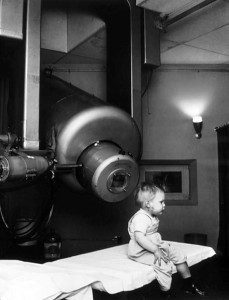
External beam radiotherapy. First patient treated with the linear accelerator (radiation therapy) for retinoblastoma in 1957. Wikipedia.
What exactly does the patient want? The end of radiotherapy or, maybe, the end of surgery? Absolutely not! Patients want the best treatment, that’s all. What does that consist of then? A 100% cure rate, 0% adverse effects, logistically practical and the retention of the quality of life.
That’s what the patient wants. There is one more essential thing that the patient wants: to be treated with respect! Just to deal with one another in a pleasant way, just to be truly noticed. I am sure the shift from care columns to integrated care pathways could give that little push toward the reduction of cultural limitations in terms of respectful treatment.
One very interesting study on what the patient really wants took place in Nijmegen (the Netherlands). In this study, patients were asked which treatment they would choose: more radiotherapy with a greater chance of being cured along with a greater risk of adverse effects, or rather, less radiotherapy, fewer adverse effects but at a cost of a reduced chance of being cured. In total opposition to doctors’ expectations, the patients opted for choice #2: fewer adverse effects at the cost of a reduced chance of being cured. It has been described in many studies that the patterns of expectation differs between doctors and patients. It is therefore essential that patients are represented on the team involved in the integrated care pathway when our oncological care systems are being restructured.
Such initiatives have already been successfully implemented. For the past 5 years, we here at Utrecht Medical Centre (UMC) have had a sounding board comprised of patients who contribute their ideas to our policies. This patient advocacy group is comprised of representatives of patient support groups who may participate independently. The goal is to discuss proposed policies; however, key points may also be addressed. I have been truly surprised by their energetic discussions and how they unravel complicated problems. They have thus become an unexpected mighty force to be reckoned with. The statement, “I have discussed with the patient advocacy group,” has become a serious argument within our organisation. There are so many groups that would like to have their points discussed at the moment that even the planning of more meetings could not resolve this issue. This also demonstrates that the patient-as-partner idea is not such a far-fetched one. The patient must assume a central role and actively participate in our integrated care pathways. I predict that the patient will even take the lead in the integrated care pathway-concept one day.
Conclusion
The end of radiotherapy. Three-quarters of an hour must be the record for disassem-bling your own academic position!
The end of the column called radiotherapy really means that the occupation has outgrown its skin. Congruent with the attempt to perform fewer surgeries, radiotherapy offers a palette of new possibilities that will cause a shift in treatment options over the coming years. This is why now is the perfect time to optimise the structural organisation of oncological care; this ‘caring in columns’ is not working most effectively for the patient. Optimal care means healthcare in which the patient assumes the central role, as an individual with a house and home life as well as a person with a medical problem which needs to be addressed with the best and most dignified care available. This can be realised by organising integrated care pathways, provided everyone benefits from the change. By using SMART as an example, I estimate the chance of succeeding to be great.
I’d like to thank each and every person who has made a contribution to this story, my story. I have made a conscious decision not to read off a list of names, but I can assure you that my gratitude toward everyone is great. The one people I’ll name personally are Jan-Willem and Justus, my wonderful X-Box whizzes, who, with their visionary behaviour, will ensure that the gaming industry’s innovative technology will also find its place within the healthcare system. Super guys! In addition, I’d like to thank my wife Mieke, my pal, with all my heart. I would have never been able to stand here today without you.
I have spoken.
In summary
The end of radiotherapy doesn’t actually concern radiotherapy. It pertains to how the healthcare system is organised and how that affects the patient. Our healthcare system is divided up into different areas of expertise, the organisation of which resembles a collection of columns, of sorts: upright, rectangular blocks, if you will. Specialist healthcare is usually organised within the column representing that relevant area of expertise. Contact between these areas of expertise appears to be less relevant. This leads to the under-utilisation of useful expertise as well as to overabundant patient treatment. Doctors are suffering from burnouts and even the Hippocratic Oath is coming under pressure. It takes an enormous amount of effort for a patient to follow a course of treatment.
Within the scope of the worldwide trend to operate less frequently, radiotherapeutic developments are proceeding the fastest and appear to be the most successful. If progression is to continue, radiotherapeutic expertise must not remain restricted to radiotherapy alone. The boundaries of the radiotherapy column no longer fit into our structural organisation of specialties.
There have been worldwide efforts to redefine radiological-column expertise; however, this is not what we really want. It would be better to reorganise by rotating the healthcare-system columnar structures with a one-quarter turn and to come up with a structure in which the patient assumes the central role. Organising care into integrated care pathways, a type of structure in which the patient assumes the central role, must be undertaken intelligently: SMART. Such a change would otherwise not be successful. In my speech, I have outlined a solution for a structural change from columns to integrated care pathways, from which all will benefit, and in which the patient will eventually take the lead.


